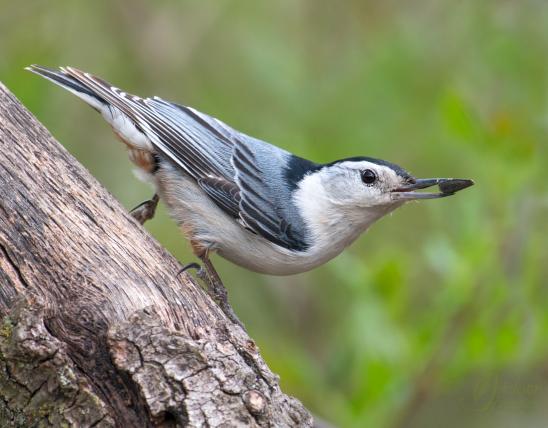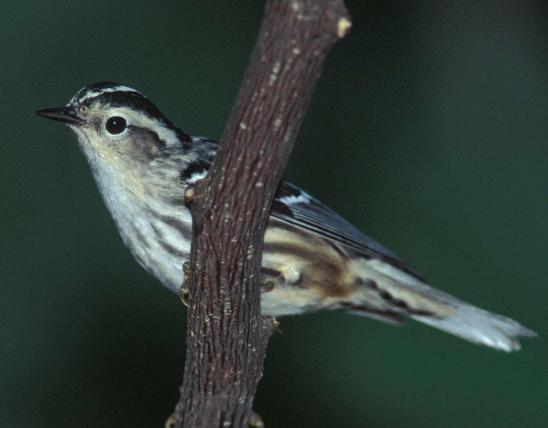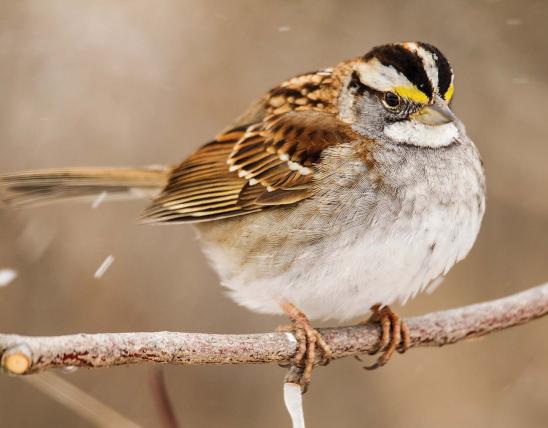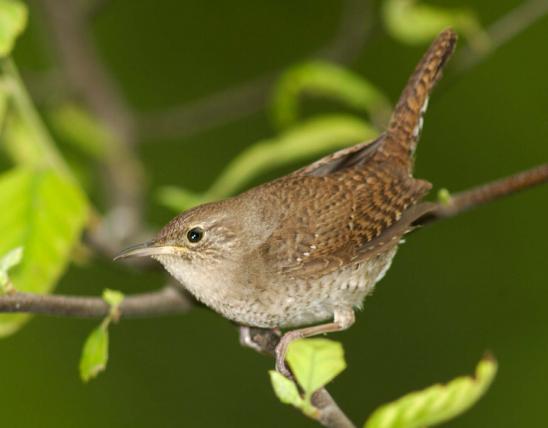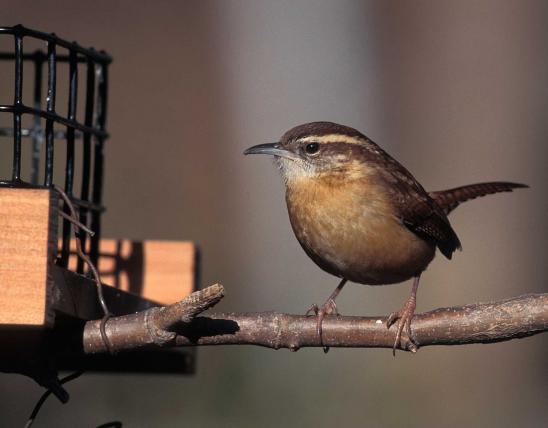
Red-breasted nuthatch upperparts are dark gray, with a dark cap and eye line and a white eyebrow. The cap is black in the male and gray in the female. Underparts are rusty, with a whitish chin and lower cheek area. Females are paler rusty on the underparts than the males. The call is a high-pitched, nasal, “yank,” “yank-yank,” or “wak, wak, wak, wak, wak.” It is sometimes described as sounding like a small tin horn. Also makes soft tseeps and tsits.
Similar species:
- The white-breasted nuthatch, a permanent resident, occurs statewide and is much more common. It is larger, has white underparts with buffy flanks, and has a black forehead crown and nape (no black-and-white stripes on the side of the head). The flanks are buffy. The song is lower-pitched and nasal: “yank-yank-yank.”
- The brown-headed nuthatch is about the same size as the red-breasted nuthatch; it’s a small, stocky bird with a brown cap. Its squeaky call sounds a lot like a rubber ducky. A species of conservation concern in Missouri and is currently being reintroduced to our state. In southern Missouri, look for Missouri’s reintroduced birds in mature pine woodlands with an open understory.
- The black-and-white warbler also creeps upside-down on trees, but it is distinctly striped with black and white and has the body shape of a warbler.
- The brown creeper also creeps around on tree trunks, but its upperparts are mottled brown, visually blending with tree bark. Its tail is stiff like a woodpecker’s, helping to prop the creeper as it climbs. It usually doesn’t climb upside-down.
Length: 4½ inches.
Statewide.
Habitat and Conservation
The red-breasted nuthatch is an uncommon Missouri winter resident in pine forests, pine stands, or even a few pines in backyards, especially when bird feeders are present. It may be very common during some winters and absent during others.
Food
Red-breasted nuthatches creep and climb along tree trunks and branches in a zigzag pattern, picking insects, spiders, and seeds from crevices. In summer, when they’re on their breeding grounds in Canada, their diet is largely insects, which provide plentiful protein for raising their young. In winter — which is when we usually see them in Missouri — their principal food is the seeds of pine cones. They may also come to backyard feeders, where they feed on sunflower seeds, suet, and peanuts.
Red-breasted nuthatches will sometimes wedge large seeds into a crevice of bark in order to peck them into smaller pieces. They also sometimes store seeds in bark crevices to eat later.
Like other nuthatches, red-breasted nuthatches often are members of mixed-species flocks that forage together. One of the ways this strategy works is because the different species — including chickadees and titmice, for example — tend to look for different types of foods, or to forage in different parts of trees or woods.
Status
Uncommon (sporadic) winter resident. Accidental summer resident and summer visitor.
Life Cycle
Red-breasted nuthatches almost never breed in Missouri. In their Canadian breeding territory, the female excavates her own nesting cavity in dead, decaying trees, often aspens, using her stout, powerful, chisel-like bill. This species may also use existing holes excavated by other nuthatches or woodpeckers. Clutches comprise 2–8 eggs, which are incubated by the female for about 12 or 13 days. Fledging occurs about 18–21 days after hatching. A red-breasted nuthatch can live to be at least 7 years old. There is only 1 brood per year.
Missouri’s red-breasted nuthatches usually spend winters here, then migrate north to Canada for the breeding season. Numbers increase during the month of September and then dwindle to virtually none by mid-May. But many populations — in Canada, several northern U.S. states, and in the U.S. Rockies and other mountain ranges — do not migrate at all. In years where pine cone production is low — about every two years — large numbers of red-breasted nuthatches from Canada may migrate south for the winter. In years with especially low amounts of pine seeds, some red-breasted nuthatches may migrate as far south as the Gulf Coast of Mississippi, Alabama, and Florida.
Human Connections
Red-breasted nuthatches are energetic visitors at winter bird feeders.
Counting the red-breasted and white-breasted nuthatches, plus the current reintroduction of the brown-headed nuthatch to Missouri, our state has three species of nuthatches, which is three-fourths of North America’s nuthatch fauna. The fourth, and smallest, U.S. nuthatch is the pygmy nuthatch, with a gray-brown cap, creamy-buff underparts, and about the shortest tail you can imagine. It is a permanent resident in pine-forested parts of many western states. If you travel to the west, make sure to look for them and listen for their peep-peep calls.
Ecosystem Connections
Nuthatches busily scan tree bark for insects, therefore helping control insect populations. Many of these insects would count as tree pests, so the presence of nuthatches is a blessing for the trees. Notably, in northern pine forests, spruce budworms (the caterpillars of certain types of native tortricid moths) periodically have super-large outbreaks, every 30 to 40 years, defoliating millions of acres of fir and spruce trees. Red-breasted nuthatches are one of the bird species that feed heavily on them.
Red-breasted nuthatches have a habit of smearing a layer of pine or fir sap around the entrance hole to their nests. They collect globs of resin with their bills and carry it to the nest, or they may use a fragment of bark — as a tool — to carry it and apply it to the edges of the hole. Apparently this layer of sticky pitch may discourage predators, would-be nest usurpers, or perhaps insect pests. It’s not a problem for the nuthatches, since they fly right through the opening without stopping to perch on the edge.


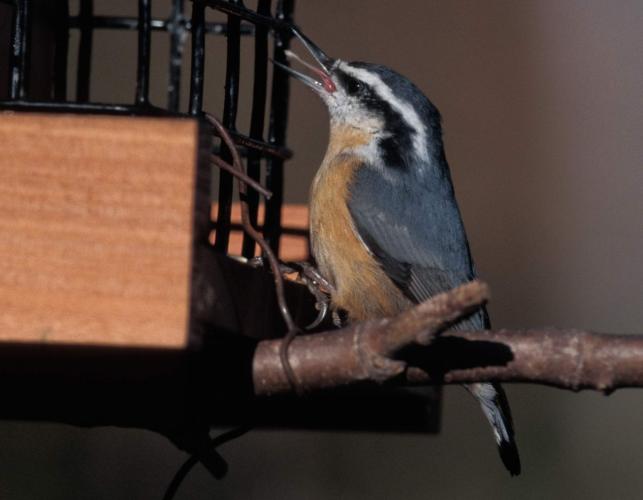











About 350 species of birds are likely to be seen in Missouri, though nearly 400 have been recorded within our borders. Most people know a bird when they see one — it has feathers, wings, and a bill. Birds are warm-blooded, and most species can fly. Many migrate hundreds or thousands of miles. Birds lay hard-shelled eggs (often in a nest), and the parents care for the young. Many communicate with songs and calls.






















